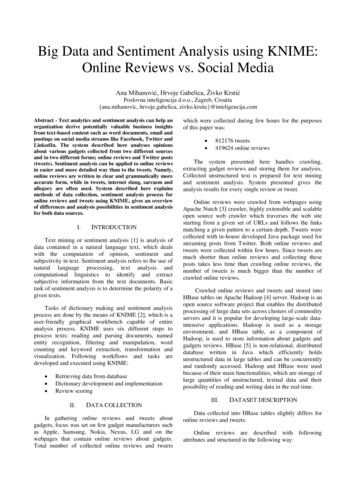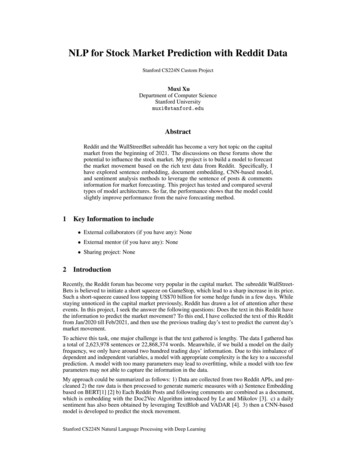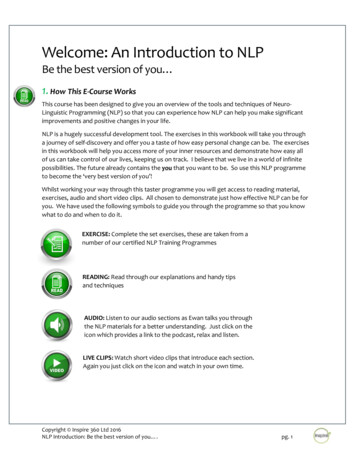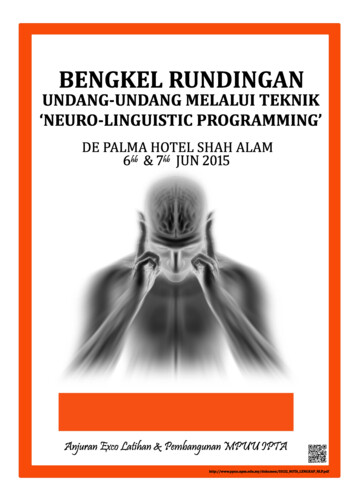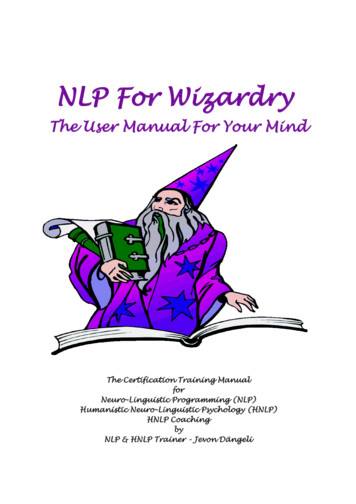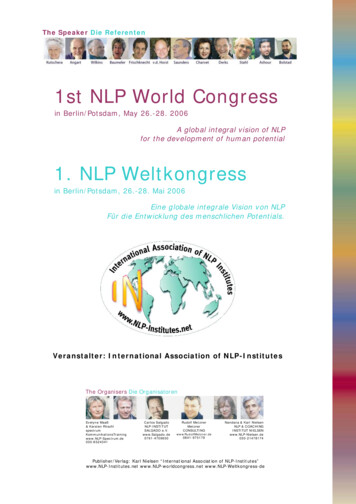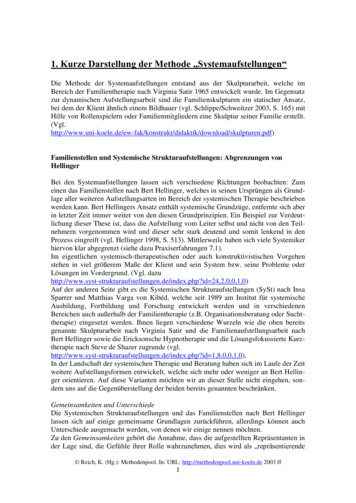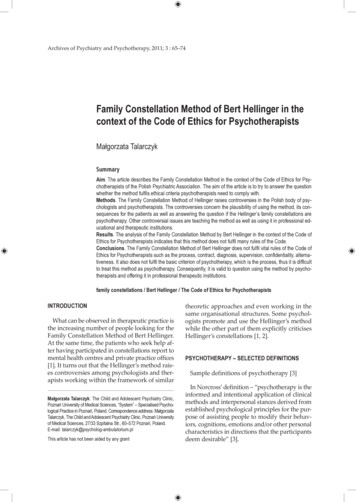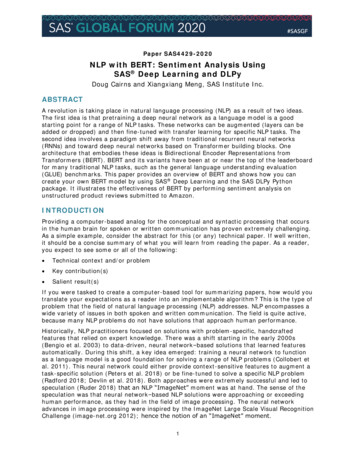
Transcription
Paper SAS4429-2020NLP with BERT: Sentiment Analysis UsingSAS Deep Learning and DLPyDoug Cairns and Xiangxiang Meng, SAS Institute Inc.ABSTRACTA revolution is taking place in natural language processing (NLP) as a result of two ideas.The first idea is that pretraining a deep neural network as a language model is a goodstarting point for a range of NLP tasks. These networks can be augmented (layers can beadded or dropped) and then fine-tuned with transfer learning for specific NLP tasks. Thesecond idea involves a paradigm shift away from traditional recurrent neural networks(RNNs) and toward deep neural networks based on Transformer building blocks. Onearchitecture that embodies these ideas is Bidirectional Encoder Representations fromTransformers (BERT). BERT and its variants have been at or near the top of the leaderboardfor many traditional NLP tasks, such as the general language understanding evaluation(GLUE) benchmarks. This paper provides an overview of BERT and shows how you cancreate your own BERT model by using SAS Deep Learning and the SAS DLPy Pythonpackage. It illustrates the effectiveness of BERT by performing sentiment analysis onunstructured product reviews submitted to Amazon.INTRODUCTIONProviding a computer-based analog for the conceptual and syntactic processing that occursin the human brain for spoken or written communication has proven extremely challenging.As a simple example, consider the abstract for this (or any) technical paper. If well written,it should be a concise summary of what you will learn from reading the paper. As a reader,you expect to see some or all of the following: Technical context and/or problem Key contribution(s) Salient result(s)If you were tasked to create a computer-based tool for summarizing papers, how would youtranslate your expectations as a reader into an implementable algorithm? This is the type ofproblem that the field of natural language processing (NLP) addresses. NLP encompasses awide variety of issues in both spoken and written communication. The field is quite active,because many NLP problems do not have solutions that approach human performance.Historically, NLP practitioners focused on solutions with problem-specific, handcraftedfeatures that relied on expert knowledge. There was a shift starting in the early 2000s(Bengio et al. 2003) to data-driven, neural network–based solutions that learned featuresautomatically. During this shift, a key idea emerged: training a neural network to functionas a language model is a good foundation for solving a range of NLP problems (Collobert etal. 2011). This neural network could either provide context-sensitive features to augment atask-specific solution (Peters et al. 2018) or be fine-tuned to solve a specific NLP problem(Radford 2018; Devlin et al. 2018). Both approaches were extremely successful and led tospeculation (Ruder 2018) that an NLP “ImageNet” moment was at hand. The sense of thespeculation was that neural network–based NLP solutions were approaching or exceedinghuman performance, as they had in the field of image processing. The neural networkadvances in image processing were inspired by the ImageNet Large Scale Visual RecognitionChallenge (image-net.org 2012); hence the notion of an “ImageNet” moment.1
Until recently, most neural network–based NLP approaches focused on recurrent neuralnetworks (RNNs). Unlike other types of neural networks, RNNs consider data ordering, so anRNN is well suited for text or audio data, where order matters. For each element in asequence, the output of an RNN depends on the current element as well as stateinformation. The state information is a function of the sequence element(s) previouslyobserved and is updated for each new element. This enables the RNN to “remember” andthus learn how sequential data evolve over time. The state calculation also makes an RNNdifficult to efficiently implement, so training can be extremely time-consuming.In 2017, the dominance of the RNN approach was challenged by the Transformerarchitecture (Vaswani et al. 2017). The Transformer is based on an attention mechanism.You can think of an attention mechanism as an adaptive weighting scheme. The output ofan attention mechanism for sequence element 𝑛 is a weighted sum of all the input sequenceelements. The “adaptive” part refers to the fact that weights are trained for each sequenceposition. Attention (Transformer) differs from recurrence (RNN) in that all sequenceelements are considered simultaneously. This approach has both performance andimplementation advantages.Bidirectional Encoder Representations from Transformers (BERT) combines language modelpretraining and the Transformer architecture to achieve impressive performance on an arrayof NLP problems. Subsequent sections present an overview of BERT and a tutorial on how tobuild and train a BERT model using SAS Deep Learning actions and DLPy.BERT OVERVIEWThis overview presents BERT from the perspective of an NLP practitioner—that is, someoneprimarily interested in taking a pretrained BERT model and using transfer learning to finetune it for a specific NLP problem. The key considerations for an NLP practitioner are theinput data representation, the model architecture, and keys for successful transfer learning,all of which are discussed in the following sections.INPUT REPRESENTATIONNeural networks cannot operate directly on raw text data, so a standard practice in NLP is totokenize the text (that is, split the text into meaningful phrase, word, or subword units) andthen replace each token with a corresponding numeric embedding vector. BERT follows thisstandard practice but does so in a unique manner. There are three related representationsrequired by BERT for any text string. The first is the tokenized version of the text. Thesecond is the position of the token within the text string, which is something BERT inheritsfrom the Transformer. The third is whether a given token belongs to the first sentence orthe second sentence. This last representation makes sense only if you understand the BERTtraining objectives. A BERT model is trained to perform two simultaneous tasks: Masked language model. A fraction of tokens is masked (replaced by a special token),and then those tokens are predicted during training. Next sentence prediction (NSP). Two sentences are combined, and a prediction is madeas to whether the second sentence follows the first sentence.The NSP task requires an indication of token/sentence association; hence the thirdrepresentation. Both training objectives require special tokens ([CLS], [SEP], and [MASK])that indicate classification, separation, and masking, respectively. In practice, this meansthat BERT text input is decomposed to three related values for each token. Figure 1 showsthe three values for all tokens in this simple example:“What is the weather forecast? Rain is expected.”2
Figure 1: BERT input for exampleThe example illustrates several important points. First, a classification token ([CLS]) beginsevery tokenized string, and separation tokens ([SEP]) conclude every sentence. Second,some words (such as forecast) can be split as part of the tokenization process. This isnormal and follows the rules of the WordPiece model that BERT employs. Finally, you seethat tokens in the first sentence are associated with segment A, while tokens in the secondsentence are associated with segment B. In the case of a single sentence, all tokens areassociated with segment A.ARCHITECTUREA BERT model has three main sections, as shown in Figure 2. The lowest layers make up theembedding section, which is composed of three separate embedding layers followed by anaddition layer and a normalization layer. The next section is the Transformer encodersection, which typically consists of N encoder blocks connected sequentially (that is, outputof encoder block 1 connects to input of encoder block 2, . . . , output of encoder block N–1connects to input of encoder block N). Figure 2 shows N 1 for ease of illustration. The finalsection is customized for a specific task and can consist of one or more layers.EmbeddingThe embedding section maps the three input values associated with each token in thetokenized text to a corresponding embedding vector. The embedding vectors are thensummed and normalized (Ba, Kiros, and Hinton 2016). Here, the term maps refers to theprocess of using the token, position, or segment value as a key to extract the correspondingembedding vector from a dictionary or lookup table.The token embedding layer maps token input values to a WordPiece embedding vector. Thetoken embedding table/dictionary contains slightly more than 30,000 entries. The positionembedding layer maps the position input values to a position embedding vector. Note thatthe position input value can be no greater than 512, so the position embeddingtable/dictionary contains 512 entries. The position value restriction also limits the length ofthe raw text string. The segment embedding layer maps the segment input value to one oftwo segment embedding vectors. All embedding vectors are of dimension D, where D istypically 768 or greater.3
Figure 2: Simplified BERT modelTransformer EncoderThe encoder block consists of layers already encountered in the embedding section—namely, addition and normalization. There are also two composite layers, called feedforwardand multi-head attention. The feedforward layer consists of two back-to-back fullyconnected (or dense) layers, where each input neuron is connected to all output neurons.Multi-head attention, shown in Figure 3, is more complex; there are three features of thiscomposite layer to highlight.First, you can see that multi-head attention requires three inputs, shown in the figure as 𝐗 𝐐 ,𝐗 𝐊 , and 𝐗 𝐕 . These are matrices, where each row is a vector of dimension D that correspondsto a token from a tokenized text string. The first row represents the first token in the string,the second row represents the second token, and so on. In Transformer terminology, 𝐗 𝐐 ,𝐗 𝐊 , and 𝐗 𝐕 are the query, key, and value inputs, respectively. Whereas multi-head attentionrequires three inputs, Figure 2 shows only a single input to the encoder. This is because theBERT encoder uses self-attention (that is, 𝐗 𝐐 𝐗 𝐊 𝐗 𝐕 ).Second, notice that there are multiple attention “heads.” An attention head projects thequery, key, and value inputs to independent lower-dimensional subspaces. This is followedby scaled dot-product attention. BERT builds on the Transformer, and the rationale formultiple heads is given in a comment in the original Transformer paper (Vaswani et al.2017): “Multi-head attention allows the model to jointly attend to information from differentrepresentation subspaces at different positions. With a single attention head, averaginginhibits this.”4
Figure 3: Multi-head attentionThe final feature to highlight is the scaled dot-product attention mechanism. To gain someinsight, consider the defining attention ��� , 𝐊 𝑖 , 𝐕𝑖 ) 𝑠𝑜𝑓𝑡𝑚𝑎𝑥(𝐐𝑖 𝐊 𝑇𝑖 ) 𝑑𝐕𝑖where the softmax operator applies to each row of the matrix product 𝐐𝑖 𝐊 𝑇𝑖 . The scalingterm 𝑑 is the dimension of the subspace. The subspace dimension is equal to 𝐷 𝐻 , where 𝐻is the number of attention heads. For a vector 𝐱, the softmax operator returns a vector, themth element of that vector, given by𝑠𝑜𝑓𝑡𝑚𝑎𝑥(𝑥𝑚 ) 𝑒 𝑥𝑚 𝑗 𝑒 𝑥𝑗Now consider what the attention equation computes. For the ith attention head, matrices 𝐐𝑖 ,𝐊 𝑖 , and 𝐕𝑖 are 𝑑 -dimension subspace projections of matrices 𝐗 𝐐 , 𝐗 𝐊 , and 𝐗 𝐕 :𝐐𝑖 𝐗 𝐐 𝐖𝐐𝑖𝐊 𝑖 𝐗 𝐊 𝐖𝐊𝑖𝐕𝑖 𝐗 𝐕 𝐖𝐕𝑖Focusing on 𝑠𝑜𝑓𝑡𝑚𝑎𝑥(𝐐𝑖 𝐊 𝑇𝑖 )𝐕𝑖 , notice that row m of matrix 𝐐𝑖 𝐊 𝑇𝑖 is the cross-correlation of thequery subspace token at position m with all key subspace tokens for a given tokenizedstring. After the softmax operation, the row m cross-correlation values become a set ofweights for combining all the value subspace tokens to create a new subspace token mrepresentation. Here you see the concept of attention at work: the new token m is mostinfluenced by (pays the most attention to) those value subspace tokens with large weights5
and is least influenced by (generally ignores) those value subspace tokens with smallweights.Scaled dot-product attention concludes each attention head, but there is a final step thatallows each head in the encoder to contribute to the new D-dimensional representation foreach token. The encoder applies a fully connected layer to the concatenated output of allattention heads, mixing the token representations from the value subspaces for each head.Task-Specific Layer(s)The custom section of the BERT model is tailored to a task, so a general overview is difficult.However, because classification-type scenarios arise in many NLP situations, a simpleexample is possible. For classification scenarios, the task-specific head is just a fullyconnected layer, in which the number of output neurons is equal to the number of classes.If the classification task is something like sentiment analysis, then the classification decisionuses the output of the fully connected layer associated with the [CLS] token. If theclassification task is token-specific (such as named entity recognition), then theclassification decision uses the output of the fully connected layer associated with thetoken(s) in question.TRANSFER LEARNINGTransfer learning describes the following process:1. Obtaining an appropriate model with pretrained parameters2. Removing layer(s) specific to the original model objective3. Adding layer(s) specific to the new model objective4. Performing fine-tuning training to optimize model parametersIn general, steps 1 and 4 are the key steps in the process. There are multiple sources forpretrained BERT models, and any of them might be suitable for your application. Onepopular source is the HuggingFace transformers GitHub repository. There you will find manyBERT pretrained models for a variety of scenarios (English-only, multilingual, and so on).You should choose the model that best matches your scenario. After selecting a BERTmodel, you must then fine-tune it with data specific to your problem. Like the original modeltraining, the fine-tuning training requires the selection of an optimization algorithm alongwith associated training hyperparameters. This can be a time-consuming exercise, butfortunately, Devlin et al. (2018) provide some helpful suggestions. The Adam optimizationalgorithm (Kingma and Ba 2015) is recommended with 𝛽1 0.9 and 𝛽2 0.999. Alsorecommended are the hyperparameter settings shown in Table 1.HyperparameterSettingDropout0.1Batch size8, 16, 32Learning rate2 10 , 3 10 5 , 5 10 5Number of epochs2, 3, 4 5Table 1: Recommended hyperparameter settings for fine-tuning6
TUTORIAL: FINE-TUNING A BERT MODELYou can use SAS Deep Learning and the SAS DLPy Python package to build and fine-tune aBERT model. To illustrate this process, consider performing sentiment analysis on anAmazon review data set with a BERT classification model. This tutorial example walksthrough the five steps you must perform and concludes with an evaluation of the trainedmodel.PREREQUISITESThis example assumes the following: The Amazon Fine Food Reviews data set from the Kaggle competition website isavailable on the client computer. You have a working understanding of Python. SAS Scripting Wrapper for Analytics Transfer (SWAT) is available on the client computer(clone, fork, or install from here). SAS DLPy is available on the client computer (clone, fork, or install from here). You have a working Python environment on the client computer that includes thetransformers package from the HuggingFace GitHub repository and PyTorch. See therecommendations here for setting up a suitable Anaconda environment. A SAS Viya 3.5 server is set up and running. An active Viya session is running in the Python environment.Note that SAS Viya is a client-server architecture, and there are references to both clientand server in the preceding list. For the purposes of this tutorial, consider the Viya client tobe a desktop PC and the Viya server to be a separate computer.STEP 1: CREATE BERT CLASSIFICATION MODELThe first step is to create a DLPy model object that encapsulates the BERT classificationmodel. Start by defining the BERT cache directory, and then instantiate an object of theBERT Model class. The BERT Model object looks in the cache directory for BERT modeldefinition and parameter information. If this information is absent, it will be downloadedfrom the HuggingFace repository:from dlpy.transformers import BERT Modelcache dir ‘path/to/your/cache-dir’bert BERT Model(viya conn,cache dir,‘bert-base-uncased’,2,num hidden layers 12,max seq len 256,verbose True)Note the viya conn variable. This is the SWAT connection to the active Viya session referredto earlier.STEP 2: PREPARE DATAThe second step is to prepare your data for training. Begin by reading the data from theAmazon Fine Food Reviews data set into a Pandas DataFrame:7
import pandas as pdreviews pd.read csv(‘name-of-your-amazon-review-file’,header 0,encoding ’utf-8’)Then assign a numeric value to indicate positive or negative sentiment for each review.Since the number of stars associated with each review ranges from 1 to 5, filter out theneutral reviews (3 stars), and then assign a negative label to 1- and 2-star reviews and apositive label to 4- and 5-star reviews:t idx reviews[“Score”] ! 3inputs reviews[t idx][“Text”].to list()targets reviews[t idx][“Score”].to list()for ii,val in enumerate(targets):inputs[ii] inputs[ii].replace(“ br / ”,””)if (val 1) or (val 2):# negative reviewstargets[ii] 1elif (val 4) or (val 5): # positive reviewstargets[ii] 2Finally, import the data preparation helper function. Invoking the helper function tokenizesthe review data and creates the three input values (token, position, segment) associatedwith each token as well as the sentiment target for each review. The helper function alsoautomatically creates a Viya table or tables containing the prepared data. The followinginvocation splits the reviews into a training set that has 80% of the overall data and atesting set that contains the remaining data:from dlpy.transfomers.bert utils import bert prepare datanum tgt var, train, test bert prepare data(viya conn,bert.get tokenizer(),input a inputs,target targets,train fraction 0.8,segment vocab size bert.get segment size(),classification problem bert.get problem type(),verbose True)STEP 3: CREATE SAS VIYA BERT MODELThe third step is to create a SAS Deep Learning model that is the equivalent of the baseBERT model plus a classification (fully connected) layer. The DLPy BERT model objectprovides a convenient function that performs this step for you:bert.compile(num target var num tgt var)Note that this function does more than just create a BERT model. It also reads the trainedparameters from the HuggingFace BERT model and saves them as an HDF5 file on the clientcomputer. This file has a predefined structure that the SAS Deep Learning actions expect.8
STEP 4: ATTACH MODEL PARAMETERSThe fourth step is to attach the trained model parameters stored in the HDF5 file to theBERT model. SAS Deep Learning actions read this HDF5 file, so it must be accessible by theViya server. Because the client computer is assumed to be separate from the servercomputer, copy or move the HDF5 file to a location where it is visible to the server:import osfrom shutil import copyfileserver dir h.join(cache oin(server dir,’bert-base-uncased.kerasmodel.h5'))This example assumes that even though the client and server computers are distinct, theyshare a common file system. If that weren’t true, then some other means of moving the filefrom the client to the server (such as FTP) would be required. When the file has beensuccessfully copied or moved, invoke the load weights() function exposed by the DLPyBERT model object to attach parameters:bert.load weights(server dir '/bert-base-uncased.kerasmodel.h5',num target var num tgt var,freeze base model False)The parameter freeze base model controls the training of the BERT model. It is set to Falsehere; this allows training of all layers of the new BERT model. If you set it to True, then onlythe final classification layer could be trained. In that case, all other model parameters wouldbe fixed.STEP 5: FINE-TUNE BERT CLASSIFICATION MODELThe final step is to perform fine-tuning training. Recall the fine-tuning recommendationsprovided by Devlin et al. (2018). The Adam optimizer and a default set of hyperparametersare defined for you when you invoke the load weights() function in step 4. If the defaultsare acceptable, you can invoke the fit() function exposed by the DLPy BERT model object. Ifyou want to override one or more of the defaults, you can call theset optimizer parameters() function before invoking fit(), as follows:bert.set optimizer parameters(learning rate 2e-5)bert.fit(train,data specs bert.get data spec(num tgt var),optimizer bert.get optimizer(),text parms bert.get text parameters(),seed 12345,n threads 32))When the fit() function finishes executing, your BERT model is fine-tuned for sentimentanalysis.9
MODEL EVALUATIONYou can now evaluate your fine-tuned sentiment analysis model by using the test data set.The predict() function exposed by the DLPy BERT model object provides a convenientmethod for this evaluation:res bert.predict(test,text parms bert.get text parameters())print(res[‘ScoreInfo’])The results of the print function are shown in Figure 4. You can see that after three epochsof fine-tuning, the model achieves slightly better than 98.0% accuracy on the test data.Figure 4: Evaluation resultsCONCLUSIONThe field of natural language processing is undergoing a revolution, thanks to the ideas oflanguage model pretraining and attention. BERT brings these concepts together to enable apowerful paradigm based on Transformer building blocks: simple fine-tuning using transferlearning provides state-of-the-art performance in many NLP tasks. This paper provides anNLP practitioner with an overview of key aspects of BERT and shows how to fine-tune andevaluate a BERT sentiment analysis model using SAS Deep Learning and the SAS DLPyPython package.REFERENCESBa, J. L., Kiros, J. R., and Hinton, G. E. (2016). “Layer Normalization.” arXiv:1607.06450v1,1–14.Bengio, Y., Ducharme, R., Vincent, P., and Jauvin, C. (2003). “A Neural ProbabilisticLanguage Model.” Journal of Machine Learning Research 3:1137–1155.Collobert, R., Weston, J., Bottou, L., Karlen, M., Kavukcuoglu, K., and Kuksa, P. (2011).“Natural Language Processing (Almost) from Scratch.” Journal of Machine Learning Research12:2493–2537.Devlin, J., Chang, M.-W., Lee, K., and Toutanova, K. (2018). “BERT: Pre-training of DeepBidirectional Transformers for Language Understanding.” arXiv:1810.04805v1, 1–14.Image-net.org. (2012). “ImageNet Large Scale Visual Recognition Challenge.” AccessedDecember 9, 2019. http://image-net.org/challenges/LSVRC/.Kingma, D. P., and Ba, J. (2015). “Adam: A Method for Stochastic Optimization.” 3rdInternational Conference for Learning Representations. San Diego: ICLR.10
Peters, M., Neumann, M., Iyyer, M., Gardner, M., Clark, C., Lee, K., and Zettlemoyer, L.(2018). “Deep Contextualized Word Representations.” Proceedings of the 2018 Conferenceof the North American Chapter of the Association for Computational Linguistics, 2227–2237.New Orleans: Association for Computational Linguistics.Radford, A., Narasimhan, K., Salimans, T., and Sutskever, I. (2018). “Improving LanguageUnderstanding with Unsupervised Learning.” OpenAI Technical Report.Ruder, S. (2018). “NLP’s ImageNet Moment Has Arrived.” Accessed December 9, 2019,https://ruder.io/nlp-imagenet.Vaswani, A., Shazeer, N., Parmar, N., Uszkoreit, J., Jones, L., Gomez, A. N., Kaiser, L., andPolosukhin, I. (2017). “Attention Is All You Need.” Advances in Neural InformationProcessing Systems 30. NIPS 2017, Long Beach, CA.RECOMMENDED READING The Illustrated Transformer (blog) BERT for Dummies—Step by Step Tutorial (blog) HuggingFace Quickstart (Transformers documentation)CONTACT INFORMATIONYour comments and questions are valued and encouraged. Contact the authors:Doug Cairnsdoug.cairns@sas.comXiangxiang Mengxiangxiang.meng@sas.comSAS and all other SAS Institute Inc. product or service names are registered trademarks ortrademarks of SAS Institute Inc. in the USA and other countries. indicates USAregistration.Other brand and product names are trademarks of their respective companies.11
Dec 09, 2019 · A revolution is taking place in natural language processing (NLP) as a result of two ideas. The first idea is that pretraining a deep neural network as a language model is a good starting point for a range of NLP tasks. These networks can be augmented (layers can be added or dropped) and then fine-tuned wit
